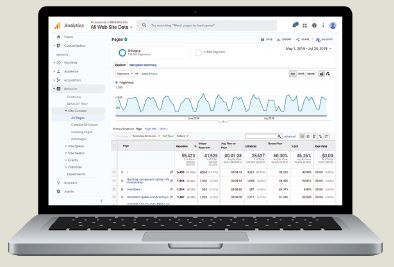Encouraging People to Visit You Online
Encouraging People to Visit You Online
“Websites are not intended to be static but instead a dynamic tool for marketing your business,” says Heather Smith, marketing coordinator at Wilson Lumber. “We know regular web updates positively impact our search engine ranking so we have a few areas of the website we update consistently,” Heather explains. “We post fresh content using our blog, monthly e-newsletter and regularly update our events and career pages.”
Regularly updating and maintaining your website content is a good search engine optimization (SEO) technique because it shows search engines that you’re keeping your site content up to date for visitors. Search engines want to provide the user conducting the search with the best experience possible and deliver the most accurate and relevant search results.
According to Junto, a Denver-based Digital Marketing agency, 75 percent of people never scroll past the first page of search engines. To that end, the main reason to use SEO on your website is to help search engines pull the best information and keywords from your website to develop a better understanding of your site and business so they recall your site more often in related search queries. This in turn will improve your website’s organic search ranking and generate more traffic to your site.

Another best practice for SEO is to include good keywords within your web content. For example, use keyword phrases such as “building components” and “wood floor trusses” to show up for more specific and relevant searches rather than using single word keywords. “We try to use keywords on the website that people might be searching for,” says Heather. “Currently we are expanding our written content on our product pages because we had a lot of photos but not a lot of content so we’re updating those pages to include more keywords.”
In order to take full advantage of your web presence it’s important to track your website performance to determine where people are landing on your website and gauge what keywords are working. “We review our Google Analytics monthly and I look at the terms or keywords that are driving people to the website and see where they go,” shares Heather. “I also look to see what pages are performing well and make sure those are up to date and that drives what we focus on. On the flipside, if there are areas that aren’t generating traffic we may revisit those pages or consider promoting those through social media or a blog post.”
Sites with a large number of visitors are viewed as popular by search engines and therefore they assume that those sites must be helpful and relevant to visitors and will rank those sites higher. This is how paid advertising such as Google Ads can increase traffic to your website and indirectly improve your site’s organic ranking. Wilson Lumber takes a unique perspective on this by partnering with suppliers for online advertising. “We work with a supplier to share the cost of advertising and then we work with an advertising agency to set up a three-month campaign based on what we want to feature,” says Heather. “The agency optimizes the cost-per-click using different keywords and then we look at the report monthly to see how the ads are performing.”
Another aspect of SEO that Wilson Lumber tracks closely is the number of visitors that are using mobile devices. “Over 50 percent of our website visitors are coming to the website from their smart phones so it’s important to have a site that’s mobile-optimized, you can’t ignore the mobile piece when looking at your web performance,” Heather states.
In this digital age, marketing has evolved because of how people interact with advertising and it’s important to take that into consideration when looking at your marketing efforts. “We don’t do a lot of traditional marketing like radio or print ads like we have in the past because we’re paying attention to how best to reach prospects and get the most out of our marketing dollars.”
These are just a few ways to improve your site SEO, but even minimal changes will help search engines better understand your website and therefore rank your site higher in search results. For more information on SEO, watch SBCA’s webinar recording on SEO best practices.
Future articles will dig deeper into best practices for on-page SEO including title and header tags and image alternative tags. We’ll also explore paid advertising and how that can help attract m ore relevant visitors to your website.
Tracking Your Website Performance Is Easy with Google Analytics
Google Analytics provides insightful data that can be useful in understanding how your visitors are interacting with your website and how your website is performing.

It’s easy to analyze your website performance by looking at the number of visitors to your website, how long they stay, and how many pages they view during their session. It may also be helpful to track where visitors came from and how they interacted with your website. These data points can give you a good overview of performance but depending on your goals you may want to track additional data such as top pageviews and conversions.
These analytical reports can give you a good sense of the areas of your website that are performing well and what areas of your website may need work. By understanding how your website and specific pages are performing, you can make valuable changes to your website to improve user experience and increase traffic to your website.
If you don’t have Google Analytics built into your website, check with your hosting company to get it added so you can take full advantage of your website as a marketing tool.

